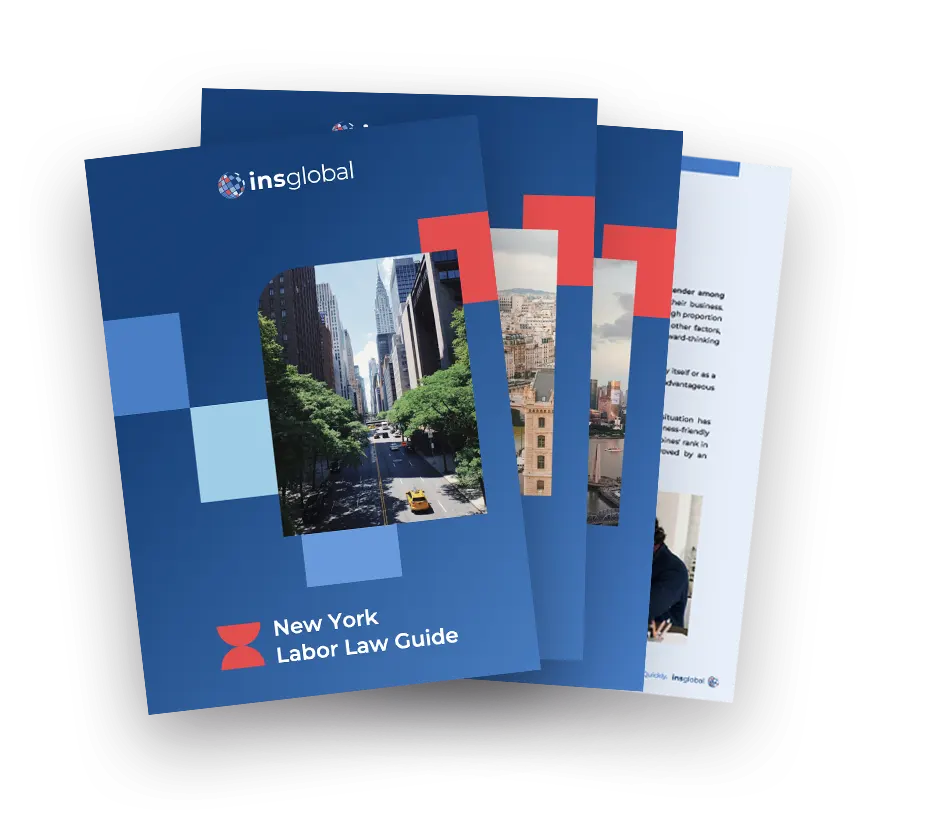Navigating the complexities of labor law is essential for any business aiming to expand internationally, and Canada is no exception. The Canadian labor law landscape is intricate, encompassing various federal and provincial regulations designed to protect workers’ rights while ensuring fair treatment by employers.
Successful expansion relies on compliance assurance to avoid hefty fines or problematic delays. So whether you’re a burgeoning startup or an established corporation, understanding these regulations is crucial to maintaining compliance and fostering a positive workplace environment.
In this guide, we’ll provide a comprehensive overview of the key aspects of Canadian labor law, particularly as they may apply to foreign employers. We’ll also introduce the concept of how partnering with an Employer of Record (EOR) like INS Global can simplify the local compliance process and make your expansion into the Canadian market seamless and efficient.

Tired of scrolling? Download a PDF version for easier offline reading and sharing with coworkers
Understanding the Fundamentals of Canadian Labor Law
Canadian labor laws are made according to the principles of protecting employees and ensuring fair working conditions. As a result, the system covers a broad spectrum of needs, including employment contracts, working hours, overtime, leave entitlements, notice periods, and termination procedures.
However, in addition to laws made at the federal level, each province and territory in Canada has its own specific labor laws that apply in their specific cases. This layered regulatory framework can be comparatively challenging to navigate, but proper attention to legal requirements is essential for any company looking to hire employees in Canada.
Employment Contracts in Canada
An employment contract is the cornerstone of the employer-employee relationship. In Canada, these contracts can be either written or verbal, but having a well-drafted written contract is highly recommended to avoid potential disputes.
Key Elements of Employment Contracts in Canada
- Job Description – A short description or list of details clearly outlining the duties and responsibilities of the employee.
- Compensation – Specifications of the salary or wage expected, including any benefits or bonuses.
- Working Hours – Definitions of expected working hours and all legal or additional overtime conditions.
- Probation Period – Details of any expected probationary period, including the duration, restrictions, and conditions for successful completion.
Termination Clauses – Clearly stated terms under which either party can terminate the contract, disputation procedures, as well as all stipulations and details concerning severance pay or termination benefits.
It’s also good practice to include details of any other relevant documents, such as Collective Bargaining Agreements (CBAs), as approximately 30% of Canadian workers are covered by a CBA, depending on their sector or position.
Legal Requirements of Contracts under Canadian Labor Law
Employment contracts in Canada must comply with the respective province or territory’s Employment Standards Act (ESA). These employment law standards typically set the minimum conditions for wages, working hours, overtime, and termination notice.
Additionally, contracts must adhere to human rights legislation as integrated into Canadian Law, which prohibits discrimination based on race, gender, age, religion, or disability.
Working Hours and Overtime
Understanding working hours and overtime regulations is crucial to maintaining compliance and ensuring fair treatment of employees, including:
Standard Working Hours
In most provinces, the standard working hours are typically 8 hours daily, Monday to Friday, and 40 hours weekly. Any work beyond 40-44 per week (depending on the province) are typically considered overtime and must be compensated accordingly.
Overtime Pay
Overtime pay is generally calculated at 1.5 times the regular hourly wage. However, specific regulations may vary according to the province or industry (depending on the presence of a CBA).
Exceptions and Special Rules
Certain professions or employees, such as managerial roles or white-collar professionals, may be exempt from standard overtime regulations, as in many other countries. Additionally, some industries have unique overtime rules contained in CBAs.
Why Have an EOR as a Partner When Creating Contracts Compliant with Canadian Labor Law?
An Employer of Record (EOR) in Canada is an expert third-party service provider than acts as the legal employer for locally-based employees on your behalf. By taking care of local contract formation and management, as well as payroll and social security contributions, an EOR ensures your full compliance with Canadian labor laws without the hassle of local company setup.
More than this, partnering with an Employer of Record (EOR) like INS Global ensures that your Canadian employment contracts remain compliant with all relevant Canadian labor laws as they evolve, so you’re never unsure of legal security. We keep track of the varying regulations across provinces to ensure your employees are compensated correctly for their overtime work.
Types of Leave: Understanding Entitlements under Canadian Labor Law
Canadian labor law provides various types of leave to ensure employees can balance their work and personal lives.
Paid and Unpaid Leave
Annual Leave – Employees are entitled to a minimum of 2 weeks of paid vacation after completing a year of employment. This increases with longer service in some provinces.
Sick Leave – Most provinces mandate a certain number of unpaid sick days per year, though this can range anywhere between 3 days and 26 weeks. Federally regulated employees are entitled to 3 paid sick days annually at a minimum.
Maternity and Parental Leave – Expectant mothers can take up to 17 weeks of maternity leave, and both parents can then share up to 63 weeks of parental leave.
Family Responsibility Leave – Employees can typically take a few days off to attend to family emergencies or responsibilities. This is typically unpaid but job-protected and normally subject to negotiation with their employer.
Special Leave Provisions
Some provinces offer additional leave entitlements. For example, in Quebec, employees can take leave for family events such as weddings or funerals, while in British Columbia, employees are entitled to leave if they are victims of domestic violence.
Total compliance means handling all aspects of leave administration, from tracking entitlements to ensuring accurate payroll adjustments. So, by partnering with an EOR like INS Global, you can ensure that all leave entitlements are properly managed and compliant with relevant legislation both at a federal and provincial level.
Notice Periods in Canada
Notice periods are an essential aspect of Canadian labor law, providing both employers and employees with a fair and reasonable timeframe when ending an employment relationship.
Minimum Notice Periods
Notice periods vary depending on the length of employment, job level, and province.
For example, in Ontario and Alberta, the requirement for a notice period is 1 week per year of service, up to a maximum of 8 weeks.
Pay in Lieu of Notice
Employers in Canada may normally choose to provide pay in lieu of a notice of termination, subject to any additional contract agreements or CBA requirements.
Termination in Canada
Termination of employment is a sensitive issue and must be handled carefully to avoid legal complications.
Just Cause Termination
Termination for just cause in Canada is seen as occurring when an employee is dismissed for serious misconduct, such as theft, fraud, or severe performance issues.
In these cases, the employer is not required to provide notice, pay in lieu of notice, or severance pay.
Termination Without Cause
Termination without cause is more common and involves ending the employment relationship for reasons not related to misconduct. This can be done by either party, either with or without prior negotiation.
However, if employers choose to terminate and employee’s contract without cause, they must provide notice or pay in lieu of notice and, in some cases, severance pay.
Severance Pay for Termination Without Cause
Should an employer terminate an employee without cause, they must provide either notice or pay in lieu of notice, and in some cases, further severance pay. However, the amount of required severance pay in Canada depends on factors such as the employee’s length of service and the terms of their contract.
In general, severance pay in Canada varies between the equivalent of 5-40 days of the employee’s standard wage. This is calculated at a federal level as 5 days plus 2 extra days per year of employment.
Constructive Dismissal
In Canada, constructive dismissal occurs when an employer unilaterally makes significant changes to the terms of employment, such as forcing a drastic reduction in salary or giving an employee a demotion, forcing the employee to resign.
This is treated as a termination, and the employee may be entitled to notice or severance pay, or may be able to dispute the changes in court.
Wrongful Dismissal
Wrongful dismissal claims in Canada arise when an employee believes they were terminated without proper notice or severance. This can lead to costly legal disputes and significant fines for employers found to be in the wrong, making it essential to follow the correct procedures.
Partnering with an EOR like INS Global can help mitigate the risks associated with termination or termination procedures in Canada. Our expertise ensures that all terminations are handled according to Canadian labor laws, protecting your business from potential legal challenges.

Establishing an Entity in Canada
Setting up a business entity in Canada involves several legal and administrative steps. While this process can be complex, it’s essential for companies looking to hire employees directly and operate within the country.
The Company Types Available in Canada
Sole Proprietorship
A sole proprietorship is Canada’s simplest and most common form of business entity. It is owned and operated by a single individual who has full control over the business.
The primary advantages of a sole proprietorship include its ease of establishment, low startup costs, and the owner’s ability to make all business decisions independently. However, a significant problem with this can be that the owner has unlimited liability, meaning personal assets can be used to cover business debts and liabilities.
Partnership
A partnership in Canada involves two or more individuals or entities conducting business together. Partnerships can be classified as either general or limited.
The advantages of a partnership in Canada include shared resources and expertise and a relatively straightforward establishment process. However, general partners face the downside of unlimited liability, and there is potential for conflicts among partners.
Corporation
A Canadian corporation is treated as a separate legal entity owned by shareholders. It can be incorporated either federally or provincially, depending on the jurisdiction chosen.
The main advantages of a corporation are limited liability for its shareholders, an easier process for raising capital, and perpetual existence, meaning the corporation continues to exist even if the ownership changes. However, there is a more complex and costly establishment process with the need to meet more regulatory requirements and ongoing compliance.
Cooperative
A cooperative is a Canadian type of business owned and operated by its members, who share in the profits and decision-making. It is typically formed to meet the common needs of its members.
The advantages of a cooperative include democratic decision-making and profit distribution among members. However, cooperatives often face challenges such as limited ability to attract outside investment and potentially slower decision-making processes due to the democratic nature of the organization.
Challenges and Considerations
Setting up an entity in Canada can be time-consuming and resource-intensive, especially for companies unfamiliar with the Canadian market or Canadian labor laws. Additionally, ongoing compliance with local laws and regulations can be challenging to manage and may require extra team members just to ensure they’re compliant.
This is where partnering with an EOR like INS Global can be beneficial. An EOR can handle all aspects of employment, from hiring and payroll to compliance and termination, without the need for you to establish a legal entity or increase your overheads.
This freedom and smaller business footprint allow you to focus on your core business activities while ensuring compliance with Canadian labor laws.
Conclusion – Why Choose INS Global for Your Canadian Expansion?
Expanding into a new market like Canada offers immense opportunities but also presents significant challenges, particularly in navigating complex Canadian labor laws. Ensuring compliance with these laws is crucial to avoid legal disputes and maintain a positive working environment.
INS Global offers a comprehensive Employer of Record (EOR) service that simplifies your expansion into Canada. By partnering with us, you can benefit from:
Expertise and Compliance Assurance – Our team of experts stays updated on the latest changes to Canadian labor laws and regulations, ensuring your business remains compliant.
Streamlined Processes – We handle all aspects of employment, from recruitment and payroll to benefits administration and termination, saving you time and resources.
Cost-Effective Solutions – Avoid the costs and complexities of establishing a legal entity in Canada. Our EOR services provide a cost-effective alternative, allowing you to focus on your core business.
Risk Mitigation – Reduce the risk of legal disputes and compliance issues with our professional support and guidance.
Choosing INS Global as your EOR partner in Canada means you can confidently expand into the Canadian market, so contact our team of expert expansion advisors today to learn more.



SHARE